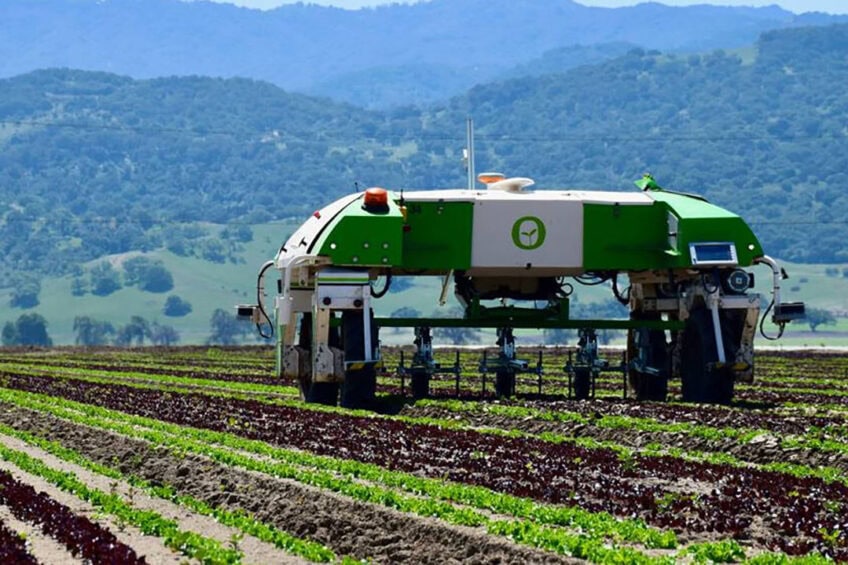VDI conference: is the time ripe for automation and robotics?

The 4th VDI conference on automation and robotics in agriculture attracted 40 participants. One of the main topics of the event was if farmers, regulation and legislation are ready for automation and robotics.
For the fourth edition of the VDI conference, some 40 international specialists on automation and robotics in agriculture gathered in Düsseldorf. Including representatives, mostly (co) founders, of field robot manufacturers such as AgroIntelli, Digital Workbench, Earth Rover, Naïo Technologies, Odd.Bot, PeK Automotive and Small Robot Company. Accompanied by speakers from multinationals such as DeLaval, Pöttinger, Sick, Trimble and Septentrio.
Field robots difficult to classify
According to Gaëtan Séverac, co-founder of Naïo Technologies, the diversity of crops is challenging when it comes to robotic hoeing and weed removal. “But not only that”, he said, “field robots are also challenging from a safety and security point of view. High crops still are a challenge compared to for instance greenhouse and warehouse robots and autonomous road vehicles. There’s still a human operator in charge of field robots. In the USA, autonomous (farm) vehicles are not prohibited. But if something goes wrong, it’s not clear who is responsible and liable (owner, operator, manufacturer, dealer, …). Yet, no one wants to stop nor slow down the developments! In 2019, our field robots still ended up in ditches and were still destroying crops while hoeing. Now, the navigation is super reliable and the challenge is ‘serviceable safety’, the mean time between human interventions.” Naïo currently has sold over 350 field robots and so far clocked 80,000 hours of autonomous navigation.
Copy-paste from industry
Josef Schmidt, CEO of Digital Workbench explained that agriculture is taking advantage of automation and autonomous advancements in the automotive industry: “All sorts of sensors and cameras to safeguard autonomous operations are now available at affordable prices thanks to the automotive industry. Such as LiDAR, radar, visual cameras, ultrasonic sensors and so on. But we can also benefit from the current EV (electric vehicle) trend. Our advantage though when it comes to safety, is that agricultural fields are normally privately owned.” Schmidt also said that he feels “only a work/operation planning done by professionals (instead of farmers) guarantees a satisfying work result of an automated system. Like in industry”.

Match field robots with the right farmers
Chuck Baresich of Haggerty AgRobotics explained how the company is putting field robots and autonomous platforms to the test in Ontario, Canada. They currently have at least 18 fields robots running in that province. “How can technology prove farming businesses? The only thing left is to remove the operator. Robotics is the next step beyond precision agriculture. Assuming chemicals are up for debate: we don’t want to be the last farmers to use glyphosate!”, he said.
In his presentation, Josef Schmidt said the way farmer’s work has to change with automation. Baresich on his behalf experiences that farmers don’t want to change the way they farm to enable field robots. “You can’t simply have field robots replace the way they’re currently working. That won’t work in Western Canada where tractor driver costs are the farmers’ lowest costs”, he said. “We therefor searched for a job we can do better with a robot despite of the fact if driving a tractor makes you a farmer.” In 2021, this resulted in the foundation of an AgRobotics Working Group with currently over 100 members to conduct on-farm demonstrations and to build networks and collaborations.
Fleet of automation products
Haggerty’s fleet of automation products currently includes robotic platforms AgroIntelli Robotti, FarmDroid FD20, Korechi Roam HCT/HCW, Naïo Oz, Dino and Orio, Nexus The Goat, Raven OMNIDrive and OMNIPower and a DJI T40 drone. Haggerty matches the field robots with farmers and specific tasks. “We’ve had quite some success with the Nexus for weeding in leafy greens but noticed in onions that The Goat wasn’t able to remove weeds as soon they reached a certain height or diameter. We also had good luck with the FarmDroid in seeding and hoeing sugar beet crops. The FarmDroid offers easy logistics because of the solar charged batteries offering 21 hours of autonomy without recharging. We seeded at a lower density with the FD20 than the conventional seed drill (45,000 versus 53,000 seeds/acre) but yielded more and larger sugar beets that were more consistent in size and shape ánd had a higher sugar content.”
The Robotti was used in strip till farming and spraying in maize and sugar beets. “Robotti runs on diesel which means the logistics are a lot more challenging in Canada. We prefer robots with two to three days of autonomy between servicing”, Baresich explained.
Are fields robots safe enough to sell to every farmer?
During his presentation, Baresich mentioned that “all robots have the same problems as all the engineers go to the same schools and develop the same problems”. “The most challenging in the mission planning software of every manufacturer are the starting and ending points and the refilling/reloading locations. We want to have choices and options to override the mission planning software. We don’t need complex, difficult to operate robots. To this respect, you can clearly tell which manufacturers have farmers working for them and which not!”
‘Are fields robots safe enough to sell to every farmer?’ also was the title of the panel discussion moderated by Future Farming. Interestingly enough, four out of five panellists feel that field robots are currently not safe enough to sell to every farmer! More about this panel discussion and safety and security of field robots later.



